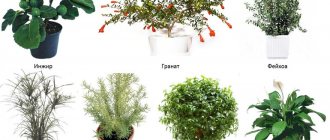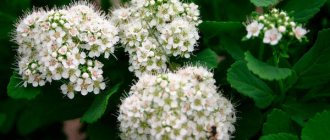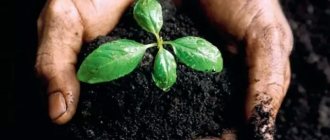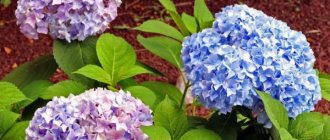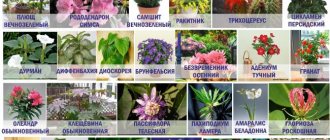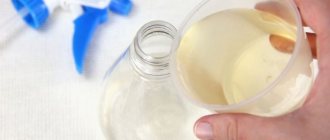There are simply no gardens that are ideal in terms of terrain and conditions. Each site has its own disadvantages - either elevation changes, specific soil characteristics, or areas with too high groundwater levels. If there is a problem area in your garden where the soil is swampy or waterlogged, do not rush to install powerful drainage and change the landscape using artificial methods.
You have a unique chance to arrange a truly unusual object - a wet flowerbed and a picturesque corner with moisture-loving plants. These are unique crops with luxurious leaves and unique flowering.
Flower garden in a damp area. © vcrown
Swamp and Siberian irises
These two types of irises cope well with moist and even swampy soil, so they can be planted on the banks of ponds and other bodies of water.
They love fertile and humus soils, partially shaded, but also sunny places. Swamp irises bloom from May to July with yellow flowers, while Siberian irises most often have a purple-blue color (there are also white and purple varieties). Both species are perennial and frost-hardy.
Which shrubs would be a good choice when decorating a garden plot?
Hedges formed from moisture-loving shrubs look attractive and are beneficial, creating a natural atmosphere and providing coolness in hot weather. It is best to plant shrubs in the fall on the border in a lowland, near a pond, to divide the garden into zonal areas. Deciduous or coniferous species of moisture-loving bushes are suitable for this.
How to choose the right moisture-loving shrubs
To do this, it is worth choosing the most suitable dacha according to the owner’s preferences, which will fit into the surrounding landscape. You need to familiarize yourself in detail with the characteristics of each species, know about flowering time, height and size of the plant. Dimensions are important in order to plant shrubs at the correct distance.
Characteristics of some types of shrubs
Gardeners prefer yew berries. Drained, moisture-permeable soil is suitable for it, so it should not be planted in places where water stagnates. Such conditions are suitable for the western thuja, whose dense growth creates a dense hedge. Privet and boxwood, which are popular among landscape designers, are considered to be lovers of moisture. Many other shrubs: fieldfare, sea buckthorn, elderberry viburnum, and Hungarian lilac thrive in moist soils.
Which moisture-loving plants do designers choose for planting in wet areas?
Among the perennial moisture-loving flowering plants that love sunny places for garden design, you can choose:
- valerian;
- blood red heuchera;
- geranium;
- swamp gladiolus;
- irises;
- forget-me-not;
- violet;
- periwinkle or others.
You can also decorate the banks of a pond, stream or artificial reservoir with plants. The list of plants is extensive, these are:
- calamus;
- veronica;
- St. John's wort;
- marigold;
- reeds and many others (you can select plants suitable for such areas).
Coastal plants will be able to tolerate different weather conditions. They captivate with their splendor and brightness of leaves and flowers. With the help of climbing varieties, it is convenient to hide, smooth out steep banks, and decorate with flowerpots with indoor flowers.
Buzulnik
Buzulnik will delight you with beautiful leaves (purple on the underside) and decorative yellow-orange flowers. Blooms in summer and until late autumn. Loves places in partial shade and even shade, and also needs constantly moist soil. It can even grow on the banks of water bodies.
This magnificent plant grows up to 1-1.5m in height and the leaves form large, spreading clumps, so it needs to be given plenty of space when planting. Overwinters without problems.
Chrysanthemums
Plants that can grow in moist soil also include chrysanthemums. It is an attractive perennial with a huge variety of varieties and flowers ranging from dark red to white.
Grows well in partial shade and light, provided the soil is constantly moist. However, it should be remembered that although the soil for chrysanthemums should be moist, it should also be fertile and permeable (water should not stand near the roots).
Transpiration
Most often, gardeners in their dachas remove excess water, of course, using a drainage system. Some trees can be a great addition to it. Such plants draw water from the ground, drying it out. This process is called transpiration.
By transpiring water through their roots, trunk and branches, trees evaporate it through their leaves. This process is useful for the plant in that it cools its parts in the heat. Each plant has its own indicators of water extraction and evaporation. This figure can be 10-600 liters per day.
One tree or bush can drain the ground within a radius of 7-12 meters around the trunk. The root system of such plants literally works like a pump.
Planting trees for drainage - biodrainage
The method of reducing groundwater levels and draining areas using green spaces - biological drainage - has been known for many years. This is possible thanks to transpiration - the ability of plants to absorb water through their roots and evaporate it through their stems and leaves.
Transpiration of water by trees.
For example, during the Soviet Union, areas with high groundwater levels were massively planted with poplars, and one adult poplar can suck up to 800 liters of water per day from the ground and evaporate. This made it possible to significantly lower the water level in the ground and help keep the foundations and basements of houses dry. And it would be stupid not to use these properties of trees now when using cesspools.
Row of pyramidal poplars.
Simple mathematics: on average, in a private house, 1 person uses about 200 liters of water per day, a family of 4 people uses 800 liters. That is, if you plant a tree, for example, a poplar, next to the cesspool, when it grows, it can completely solve the problem of wastewater disposal on the site. However, few people decide to plant a poplar near their house. The tree will grow huge, the neighbors will obviously not be happy, and when the time comes and it needs to be cut down, this will result in a serious problem. Not to mention the poplar fluff.
Requirements for plants for waterlogged areas
The main requirements for such plants are a love for a high level of moisture and a fear of flooding and stagnation of moisture in the soil. They must be able to withstand low oxygen concentrations in the soil and be able to withstand flooding and getting wet. But sufficient endurance and resistance to frost are equally important. After all, soil saturated with moisture creates specific and more severe conditions, freezing earlier than ordinary garden soil, and thawing much later.
Lysichiton in the design of a waterlogged area. © Kathryn Mezger
Crops that can settle in waterlogged, swampy areas in the garden are very different. They are conventionally divided into:
- decorative deciduous, the flowering of which is rather inconspicuous;
- beautifully flowering (but their foliage is also always quite attractive).
You can find your moisture-loving stars among perennials and even among annuals. But most crops are still classified either as giants (trees and shrubs from viburnum to hydrangea and maples), or as herbaceous perennials that will decorate such areas for decades.
Plants that can grow in damp areas are suitable for decorating various water bodies and prefer to settle in shallow water or in swamps. But there are also plants that are more often used in decorative swamps or wet flower beds, and not in reservoirs. Wet flower beds, although rare, are becoming increasingly widespread and help solve problems without drastic measures and significant funds.
Kaluzhnitsa
Marigold is a plant that not only can grow in moist soil, but also needs it, so the banks of reservoirs are considered an excellent place.
It blooms with yellow flowers from May to June.
The leaves are dark green, form not very large clusters and grow to about 30-40 cm in height. Marigold loves sunny or slightly shaded places and is resistant to frost and pests. All parts of the plant are poisonous!
Begonia
One of the most common flowers, which is both moisture-loving and drought-resistant. The plant is loved by gardeners due to its long flowering period. Decorative deciduous and decorative flowering varieties of begonia are used for growing indoors. Some varieties are able to retain their original leaves throughout the year, but the most beautiful are tuberous begonias, which have luxurious flowers.
These plants are completely unpretentious in care and resistant to many diseases. It is advisable to place the flower pot in a well-lit place with diffused sunlight. Water the plant as the top layer of soil dries. To maintain optimal soil moisture, the flower pot can be placed in a tray with wet peat. On hot summer days, it is advisable to spray begonia with a spray bottle.
Loosestrife
Merlin grows wild and is quite common in Russia, but it can also be grown as an ornamental plant.
It has characteristic long inflorescences with pink or carmine flowers that bloom all summer. Can grow in sun or partial shade and does especially well around bodies of water.
Frost-resistant and undemanding. It is also worth saying that loosestrife is not only a honey plant, but also a medicinal plant. And in addition to wild species, decorative varieties with more spectacular inflorescences have also been bred.
Areas with high humidity are not a problem, but an opportunity
The most problematic areas are considered to be areas with high, constant humidity and dampness. Of course, to arrange a vegetable garden and orchard, such conditions need to be changed with a drainage system, but for decorative compositions this is not at all necessary. Moreover, if we are talking only about a small area or corner of the garden.
Such wet gardens are an example of landscape, natural beauty. By choosing the right plants, you can create colorful flowering arrangements even in such seemingly unfavorable conditions.
Volzhanka dioecious
Another spectacular plant, the leaves and stems of which form a compact bush.
In June and July, the tips of the stems are crowned with tall flower shoots with paniculate inflorescences of white or cream flowers. During this period, the plant can reach a height of more than 2 m.
Volzhanka dioecious needs fertile, humus and constantly moist soil. Grows best in partial shade.
Tips for landscape design.
Agricultural technology of moisture-loving perennial plants
Plants in this group typically have large leaves and tall stems. They prefer moist areas or regular watering. With a lack of water, flowers and leaves become smaller and lose their brightness.
Tall moisture-loving plants:
aquilegia, aconite, astilbe, Volzhanka, delphinium, dicentra, Siberian iris, marigold, swimsuit, daylily, lychnis, monarda, foxglove, rudbeckia, cyanosis, solidago, tradescantia.
Low-growing moisture-loving plants:
bergenia, periwinkle, heuchera, hoofweed, lily of the valley, buttercup, forget-me-not, primrose, lumbago, violet.
Sun loving plants:
aquilegia, aconite, heuchera, delphinium, dicentra, Siberian iris, marigold, bathhouse, daylily, lychnis, monarda, foxglove, lumbago, rudbeckia, cyanosis, solidago, tradescantia.
Shade-tolerant moisture-loving plants:
aquilegia, aconite, astilbe, bergenia, periwinkle, volzhanka, dicentra, Siberian iris, hoofweed, swimsuit, lily of the valley, buttercup, monarda, foxglove, forget-me-not, pachysandra, primrose, violet.
Moisture-loving plants that prefer slightly acidic soil:
Arends astilbe - compost is added every two years, the bush is divided every four years, in the first year it requires shelter for the winter;
bergenia cordifolia, small periwinkle, lily of the valley, hybrid daylily, purple foxglove, glossy rudbeckia - pinch shoots for better tillering; dicentra is magnificent - in open sunny places it suffers from late spring frosts;
Siberian iris - planting depth no more than 3-5 cm, in autumn the leaves are cut to a height of up to 10 cm, does not tolerate damp soils;
marsh marigold - after flowering, the leaves turn green and grow, the whole plant is poisonous;
European swimsuit - for re-blooming, faded flower stalks are cut off, requires systematic mulching;
primrose, fragrant violet - dividing the bush every 3-4 years;
blue cyanosis - after flowering it loses its decorative effect, requires short pruning in the fall, peat is added before planting; Tradescantia virginiana - in bright light the intense green color of the leaves is lost; it likes frequent spraying.
Moisture-loving plants preferring neutral or slightly alkaline soil:
Hybrid aquilenia requires pruning of faded flower stalks and mulching of plantings in the spring;
aconite capulaceae is responsive to organic fertilizers, dividing the bush once every 3-4 years, poisonous; blood-red heuchera does not tolerate stagnant water, dividing the bush every 3-4 years;
delphinium - pruning faded shoots for re-flowering, dividing the bush every 4 years;
Lychnis chalcedony - for repeated flowering, trim the stems by 15-20 cm and fertilize, dividing the bush every 3-4 years;
solidago-hybrid needs support; in the fall, pruning to a height of up to 15 cm.
Moisture-loving plants for calcareous soil:
double monarda does not tolerate heavy acidic, swampy soils, in dry places it is affected by powdery mildew;
Common lumbago requires rich, drained, deeply cultivated soil, is short-lived in cultivation, tolerates partial shade, and does not respond well to transplanting.
Plants for clay and loamy soils:
aconite, astilbe, bergenia, periwinkle, volzhanka, delphinium, iris, marigold, hoofweed, swimsuit, daylily, lychnis, monarda, foxglove, forget-me-not, lumbago, rudbeckia, solidago, tradescantia, violet.
Plants for peaty soils:
bergenia, dicentra, marigold, hoofweed, lily of the valley, daylily, ranunculus, foxglove, forget-me-not, primrose, solidago, tradescantia.
Agricultural technology of drought-resistant perennial plants
These are crops that do not require watering for a long time or do without it at all, as a rule, with small or heavily dissected leaves.
Tall drought-resistant plants used in mixborders:
cornflower, gaillardia, heuchera, coreopsis, peppermint, wormwood, eryngium, yarrow, evening primrose, etc.
Low-growing drought-resistant plants, used mainly for rockeries and alpine slides:
Arabis, periwinkle, speedwell, carnations, tenacious, bell (Portenschlag, Pozharsky), young, aubrieta, sedum, lumbago, stachys, thyme, subulate phlox, hosta.
For sunny open areas
choose plants with grey-green, glaucous or bluish leaves, often with pubescence or a waxy coating as protection from bright sunlight. Plants with purple, yellow or yellow-variegated leaves also do well.
For example: arabis, speedwell, gaillardia, carnations, gypsophila, bells, coreopsis, spurge, peppermint, aubrieta, sedum, wormwood, eryngium, stachys, thyme, yarrow, phlox awl-shaped, evening primrose, sprout.
For shady areas
choose plants with hairless, smooth leaves of a juicy green color. For example: cornflower, speedwell, gaillardia, heuchera, bluebells, sedums, lumbago tolerate some shading. Periwinkle, tenacious, cypress spurge, white-variegated warbler, hosta grow in shady places.
Most low growing plants
need light, loose soils, sandy loam or sandy in texture. The most striking examples: speedwell, tenacious, sedums, of which the hardiest sedums are white, prominent, caustic, false, recurved, awl-shaped phlox.
Tall plants: gaillardia, angustifolia lavender, lychnis chalcedony, pyrethrum, wormwood, alpine eryngium, evening primrose, etc.
Plants for clay soils:
tenacious, peppermint, paniculata phlox, etc.
Drought-resistant plants
, preferring loose, poor, dry soils with an alkaline reaction of the environment: all ground covers of mountain origin: arabis, alyssum, iberis, aubrieta, jaskolka. Excess humus and fertilizers for these plants means loss of compactness and weakens flowering.
Mountain species of bells (Carpathian, Portenschlag) also prefer alkaline soils, but with sufficient nutrition. Portenschlag bluebell can be invasive, and Carpathian bluebell needs stems to be cut after flowering.
Other plants for calcareous soils:
juveniles require open space, dry, poor soil.
Soil with more nutrients leads to the formation of large rosettes, but the color fades; Such plants winter worse. Water the plants once after planting. In damp soil, the lower leaves rot. The resulting peduncles are immediately removed, otherwise the rosettes die off after flowering: aubrieta does not tolerate souring, heavy, waterlogged soils, or oily soil, therefore it requires additional surface application of sand 2-3 times a season in a layer of 3-5 cm. Requires a sunny place, watering is necessary only for young plantings. After May flowering, plants are pruned for new and compact growth. Repeat flowering is possible in autumn. With age, varietal shaving becomes more capricious;
common lumbago requires good, deep soil preparation, does not tolerate waterlogging, blooms in the 2-3rd year, adult plants do not tolerate replanting well, requires rich, drained soil;
Phlox subulate loves a sufficient amount of sun, does not tolerate excess water or acidic dense soils. Retains decorative effect for 4-5 years or more. Repeat flowering occurs in August - September.
Plants that are undemanding to soil
Sedums are undemanding when it comes to watering and fertilizing, grow quickly, and are photophilous, with the exception of the Spanish shoot-bearing variety.
Subject to overgrowth or loss. After 3-6 years, division or cuttings are necessary. Not competitive with weeds. They require little shelter for the winter and do not immediately have a decorative appearance in the spring: Siebold, Spanish, Lydian, Eversa. Sedums for gardens with individual care: palmate-leaved and its varieties Sarah Bianca with white leaves and Purpureum with red leaves. Sedums with easy care: Siebold, Kamchatka, bent, Eversa.
Selection of plants by color of flowers, inflorescences and leaves
Red gamma:
aquilegia, amaranth, anemone, antirinum, astilbe, aster, balsam, tuberous and flowering begonia, verbena, viola, carnation, heuchera, dahlia, geranium, hyacinth, gladiolus, knotweed, sweet pea, gravilate, irisinia, bearded iris, canna, clematis , castor bean, coleus, crocus, cinquefoil, daylily, Asiatic lily, lychnis, lobelia, lupine, poppy, mallow, monarda, foxglove, pelargonium, perilla, petunia, peony, purslane, primula, rhododendron, roses, salvia, tagetes, yarrow, tulip, decorative bean, Drummond phlox, paniculata, subulate, comb and paniculata celosia, zinnia.
Pink range:
ageratum, aquilegia, anemone, antirinum, seaside armeria, astilbe, aster, bergenia, balsam, tuberous begonia, flowering begonia, cornflower, carnation, dahlia, geranium, hyacinth, gladiolus, knotweed, sweet pea, gravilat, delphinium, dicentra, fragrant tobacco , iris, morning glory, saxifrage, clematis, cleome, bell, cosmos, crocus, lavatera, cinquefoil, daylily, lily, lobelia, onion, lupine, poppy, mallow, daisy, monarda, foxglove, forget-me-not, osteospermum, sedum, pelargonium, penstemon , petunia, peony, primrose, rhododendron, roses, salvia, scabiosa, resin, statice, yarrow, tulip, Drummond phlox, paniculata, subulate, zinnia.
Violet color:
ageratum, aconite, alyssum, anhusa, aster, periwinkle, autumn crocus, cornflower, speedwell, viola, purple bindweed, carnation, heliotrope, dahlia, geranium, gladiolus, sweet pea, hydrangea, loosestrife, iris, clematis, bluebell, crocus, liatris, lobelia, lupine, onion, plumbago, primrose, checkered hazel grouse, tradescantia, tulip, violet, phlox, fuchsia, echium.
Blue and light blue colors:
ageratum, aquilegia, aconite, anemones, anhusa, aster, periwinkle, brunnera, cornflower, speedwell, viola, hyacinth, gladiolus, gentian, hydrangea, delphinium, tenacious, morning glory, iris, clematis, bellflower, crocus, lavender, flax, lobelia, lupine, onion, lungwort, muscari, forget-me-not, nigella, liverwort, plumbago, statice, scylla, tradescantia, tulip, violet, phlox, hosta, chrysanthemum, sage, echium.
White-silver color scheme:
ageratum, aquilegia, alissum, amobium, anafalis, anemone, antirinum, anhusa, arabis, armeria, astilbe, aster, balsam, tuberous begonia, flowering begonia, cornflower, verbena, viola, Volzhanka, bindweed, galanthus, carnation, dahlia, geranium, hyacinth, gypsophila, gladiolus, sweet pea, hydrangea, delphinium, dimorphotheca, dicentra, iberis, iris, saxifrage, clematis, cleome, bellflower, cosmos, crocus, lavatera, lily of the valley, cinquefoil, leftflower, liatris, lily, lobelia, lupine, poppy , daisy, matricaria, hellebore, muscari, foxglove, narcissus, forget-me-not, nigella, osteospermum, sedum, pelargonium, penstemon, petunia, peony, pyrethrum, wormwood, rhododendron, roses, checkered hazel grouse, salvia, scabiosa, statice, stachys, fragrant tobacco , tiarella, tradescantia, yarrow, tulip, violet, phlox paniculata, awl-shaped, hosta, chrysanthemum, cineraria, zinnia, echium, chickweed, spotted lariat.
Yellow range:
adonis, aquilegia, antirinum, balsam, buzulnik, cornflower, loosestrife, viola, gaillardia, gazania, helenium, helichrysum, dahlia, gladiolus, doronicum, honeysuckle, St. John's wort, iris, calendula, calceolaria, canna, coleus, coreopsis, mullein, cosmos, crocus, bathhouse, cinquefoil, daylily, lily, lupine, mantle, matricaria, mimulus, narcissus, nasturtium, sedum, sunflower, primrose, broom, rose, rudbeckia, imperial hazel grouse, solidago, statice, tagetes, telekia, yarrow, tulip, fritillaria , chrysanthemum, celosia, evening primrose, eschscholzia.
Orange range:
antirinum, buzulnik, viola, gazania, gaillardia, honeysuckle, calendula, coreopsis, cosmos, cinquefoil, daylily, oriental and Icelandic poppy, mimulus, sunflower, primula, rhododendron, roses, imperial hazel grouse, tagetes, yarrow, ursinia, chrysanthemum, celosia, zinnia, eschscholzia.
Green range:
alternanthera, asparagus, euonymus, budra, coleus, kochia, mantle, young, spurge, hellebore, bryozoan, fescue, ferns, pachysandra, plectranthus, mignonette, chlorophytum, echeveria, herbs.
(Materials from M.V. Velikotnaya were used)
Astilbe
A beautiful and colorful perennial that blooms for a long time and has a fairly compact size. The plant is grown in many gardens and not necessarily in wetlands.
However, in summer it requires regular and intensive watering, because during drought, growth may slow down and flowering may stop.
It is best to plant astilbe in moist and semi-shaded places. The soil, although moist, must be permeable, fertile and humus, which will give more abundant and vibrant flowering.
Spiraea
Meadowsweet is another plant to consider if you have waterlogged soil in your garden. In Russia it grows wild, so you will not have problems adapting to the climate.
It is a disease-resistant perennial that blooms all summer with white and cream paniculate inflorescences consisting of many tiny, pleasantly scented flowers.
Meadowsweet grows up to 2m tall and grows best in moist, moist soil in partial shade or full sun. It is worth knowing that it is also a medicinal plant.
What to plant in waterlogged soil?
7 Suitable Plants for Wet Soil (Will Grow Where You Never Expected!)
- 1 Arizema Arizema has incredibly beautiful dark red striped inflorescences-fruits, vaguely reminiscent of calla lilies. ...
- 2 Calla marsh...
- 3 Forget-me-not marsh...
- 4 Orchids...
- 5 Echinacea…
- 6 Swamp Hibiscus…
- 7 Swamp geranium
Interesting materials:
What does the microphone icon mean on iPhone? What does the microphone icon on the iPhone screen mean? What does the don't stop sign mean? What does the no overtaking sign mean? What does the ok sign mean? What does the Korean finger sign mean? What does the Intersection with a secondary road sign mean? What does a pedestrian crossing sign in a red triangle mean? What does the chase sign mean? What does the crescent moon sign mean on iPhone in messages?
Basilisk
Various types of cornflower love moist soil, so they can be planted near bodies of water, preferably in partial shade.
The plant has delicate feathery flowers in pink, purple, as well as white and yellow. On sale you can find several species that differ in color, shape and size of leaves, although they are all quite large plants (from 1 to 2 m in height).
Mint
Mint is also decorative, healthy and all its types like moist soils. In nature, mint grows near bodies of water, so in the garden it is best to plant it in partial shade or shade. Mint can be used as part of medicinal and ornamental plantings.
Thus, longleaf mint has characteristic silvery leaves and elongated purple inflorescences, and grows up to 1 m in height.
12. Common yarrow
Common yarrow grows in nature in damp places, but can also be used as an ornamental plant; even several varieties have been bred.
It grows up to 30 cm in height and forms dense inflorescences of small flowers. It can be grown in a flowerbed or on a balcony in a container.
Unlike other species, it requires moist soil and sunny or partial shade. It blooms from June to August, the flowers can be used for cutting.
You may also find the following materials useful:
- How to choose good seedlings of ornamental shrubs: tips and tricks
- Which garden shrubs are best planted outside the site?
- Getting rid of licorice in your summer cottage: effective methods and life hacks
- Garden ivy: planting and care in open ground, reproduction, diseases and pests
- Pots and baskets with flowers in the garden - a stylish decor option for a summer cottage
Moisture-loving herbs
Grasses in nature are accustomed to extreme conditions. These are moisture-loving and at the same time persistent plants. If you forget to water them, they will turn into a clump of hay sticking out of the pot. They react instantly to fresh water and send out fresh shoots. With abundant watering they turn green and even bloom.
Known species:
- calamus;
- hanging reeds;
- indoor bamboo.
Calamus is a marsh grass and looks the same. Indispensable in indoor mini-gardens as a background for more spectacular moisture-loving plants. In long boxes it creates a grassy wall for decorating office partitions and window sills in entrances, because it is not afraid of drafts and cold.
But despite its unsightly appearance, calamus perfectly purifies the air in the room. The plant is used in medicine, and the roots are used in cooking as a seasoning. There is no need to eat indoor calamus, which has purified the air and absorbed harmful impurities.
Hanging reed is a marsh sedge with thin stems. The stems first stretch upward, then descend. This is how hummocks form in swamps; in a pot or flowerpot, the reed stems hang beautifully over the edges without losing their freshness. Flowers in the form of whitish balls at the very tips of the stems. Because of this unusual flowering pattern, trailing reeds are sometimes mistaken for plastic greenery.
Hanging reed likes to keep the pot always wet, but in winter it needs a short period of rest to renew itself.
Pogonaterum is called bamboo because of its external resemblance; in fact, it is a plant from the cereal family, native to Southeast Asia. There are tall and short varieties. The plant dies quickly without abundant watering, but is not demanding in other conditions. Designers love it because this imitation of bamboo will add the right mood to an oriental-style interior.
